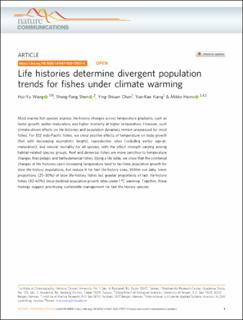| dc.contributor.author | Wang, Hui-Yu | |
| dc.contributor.author | Shen, Sheng-Feng | |
| dc.contributor.author | Chen, Ying-Shiuan | |
| dc.contributor.author | Kiang, Yun-Kae | |
| dc.contributor.author | Heino, Mikko Petteri | |
| dc.date.accessioned | 2021-03-30T11:05:11Z | |
| dc.date.available | 2021-03-30T11:05:11Z | |
| dc.date.created | 2020-08-14T12:55:50Z | |
| dc.date.issued | 2020-08-14 | |
| dc.identifier.issn | 2041-1723 | |
| dc.identifier.uri | https://hdl.handle.net/11250/2736114 | |
| dc.description.abstract | Most marine fish species express life-history changes across temperature gradients, such as faster growth, earlier maturation, and higher mortality at higher temperature. However, such climate-driven effects on life histories and population dynamics remain unassessed for most fishes. For 332 Indo-Pacific fishes, we show positive effects of temperature on body growth (but with decreasing asymptotic length), reproductive rates (including earlier age-at-maturation), and natural mortality for all species, with the effect strength varying among habitat-related species groups. Reef and demersal fishes are more sensitive to temperature changes than pelagic and bathydemersal fishes. Using a life table, we show that the combined changes of life histories upon increasing temperature tend to facilitate population growth for slow life-history populations, but reduce it for fast life-history ones. Within our data, lower proportions (25–30%) of slow life-history fishes but greater proportions of fast life-history fishes (42–60%) show declined population growth rates under 1 °C warming. Together, these findings suggest prioritizing sustainable management for fast life-history species. | en_US |
| dc.language.iso | eng | en_US |
| dc.publisher | Nature Research | en_US |
| dc.rights | Navngivelse 4.0 Internasjonal | * |
| dc.rights.uri | http://creativecommons.org/licenses/by/4.0/deed.no | * |
| dc.title | Life histories determine divergent population trends for fishes under climate warming | en_US |
| dc.type | Journal article | en_US |
| dc.type | Peer reviewed | en_US |
| dc.description.version | publishedVersion | en_US |
| dc.rights.holder | Copyright The Author(s) 2020 | en_US |
| dc.source.articlenumber | 4088 (2020) | en_US |
| cristin.ispublished | true | |
| cristin.fulltext | postprint | |
| cristin.qualitycode | 2 | |
| dc.identifier.doi | 10.1038/s41467-020-17937-4 | |
| dc.identifier.cristin | 1823358 | |
| dc.source.journal | Nature Communications | en_US |
| dc.source.40 | 11 | |
| dc.source.pagenumber | 1-9 | en_US |
| dc.relation.project | Norges forskningsråd: 288037 | en_US |
| dc.relation.project | Andre: MOST 105-2811-M-002-068 | en_US |
| dc.identifier.citation | Nature Communications. 2020, 11, 4088 (2020), 1-9 | en_US |
| dc.source.volume | 11 | en_US |

